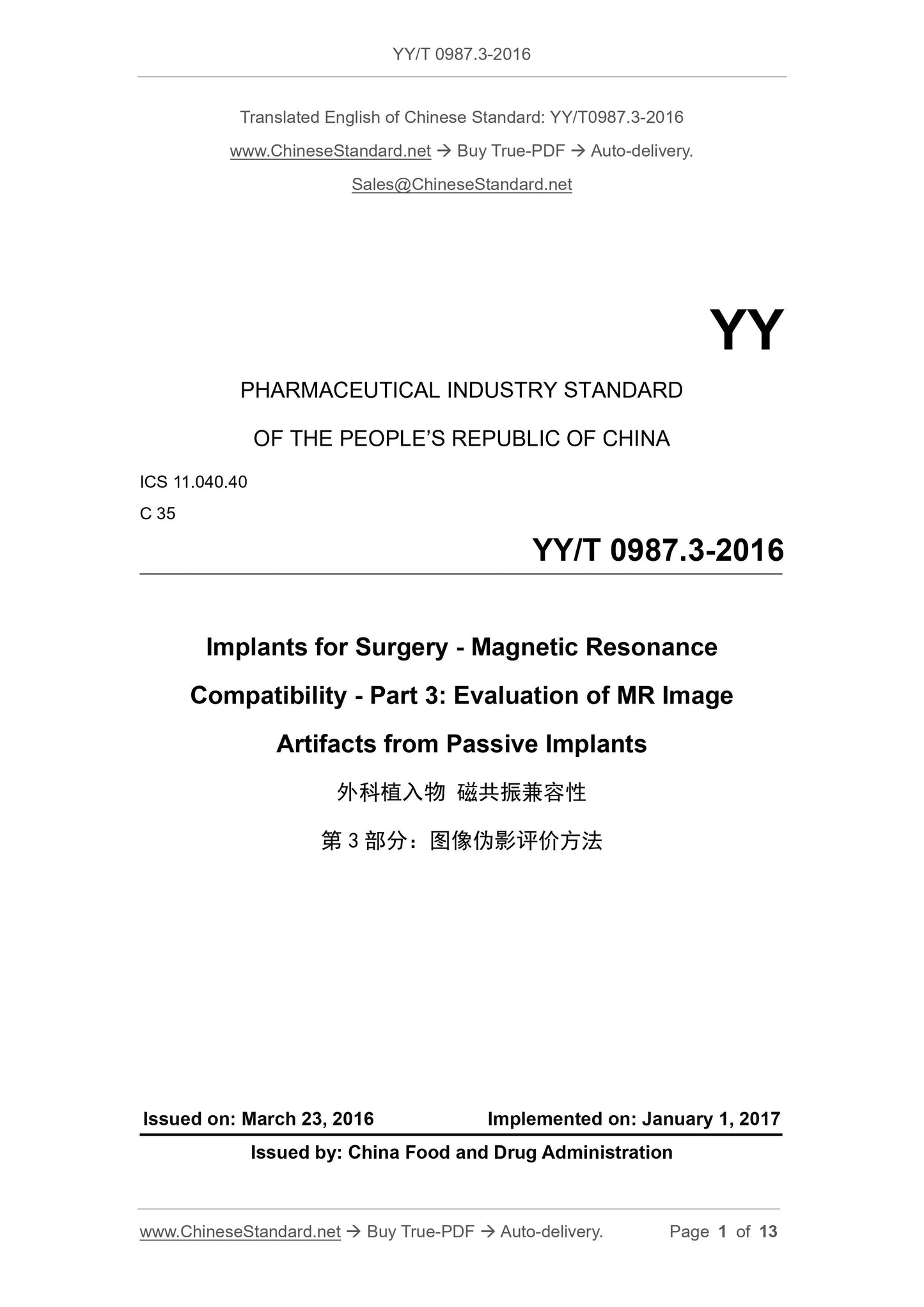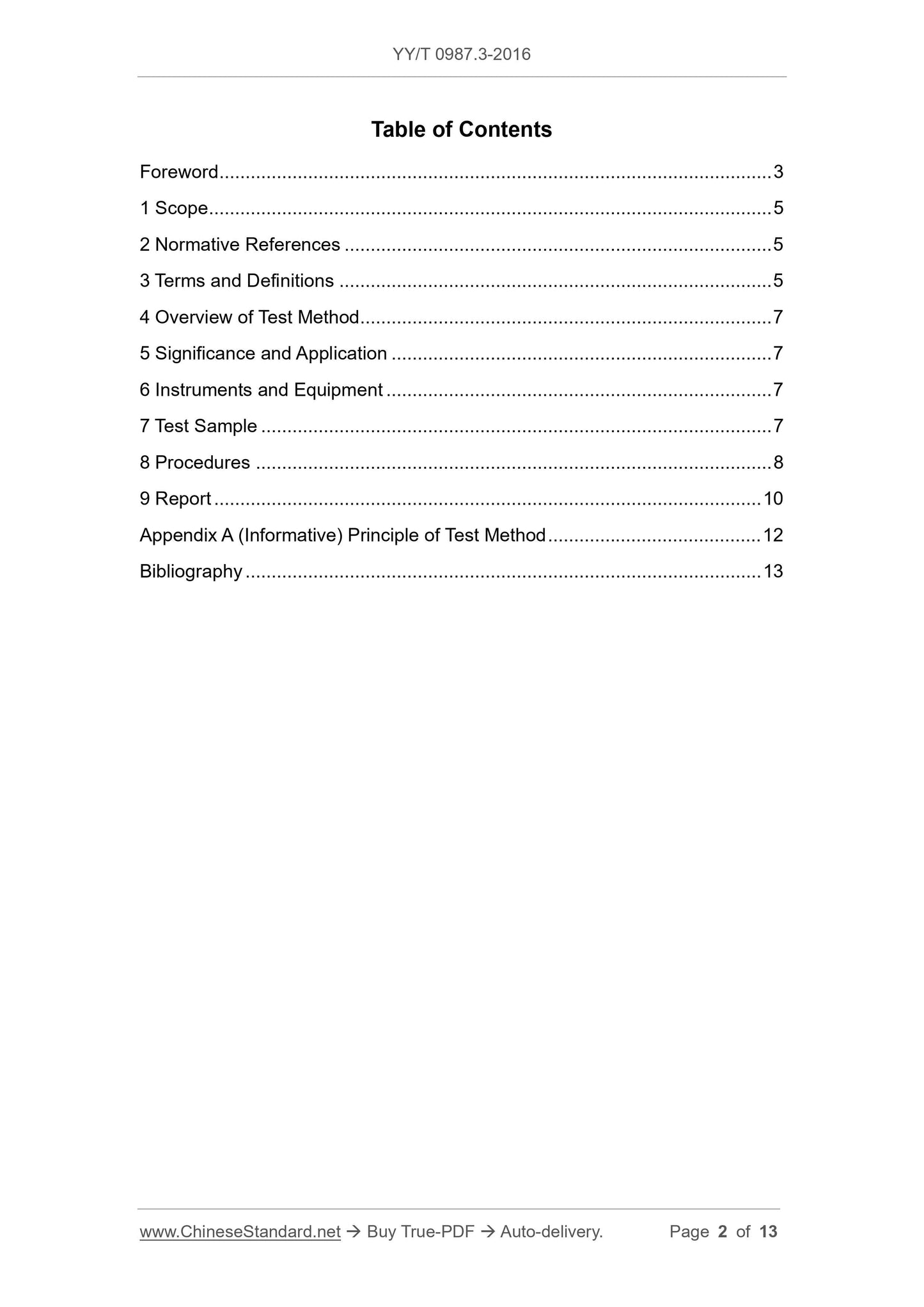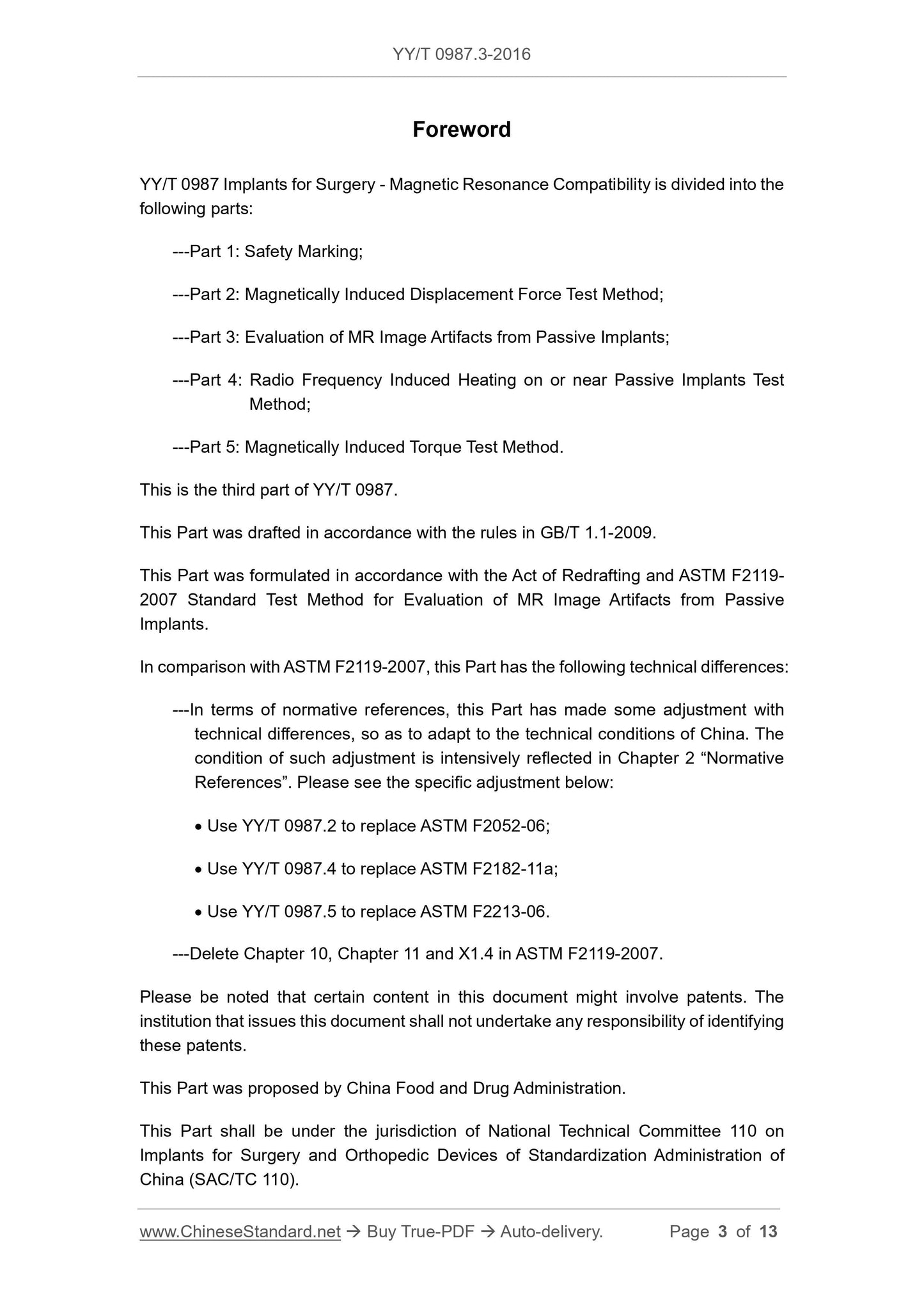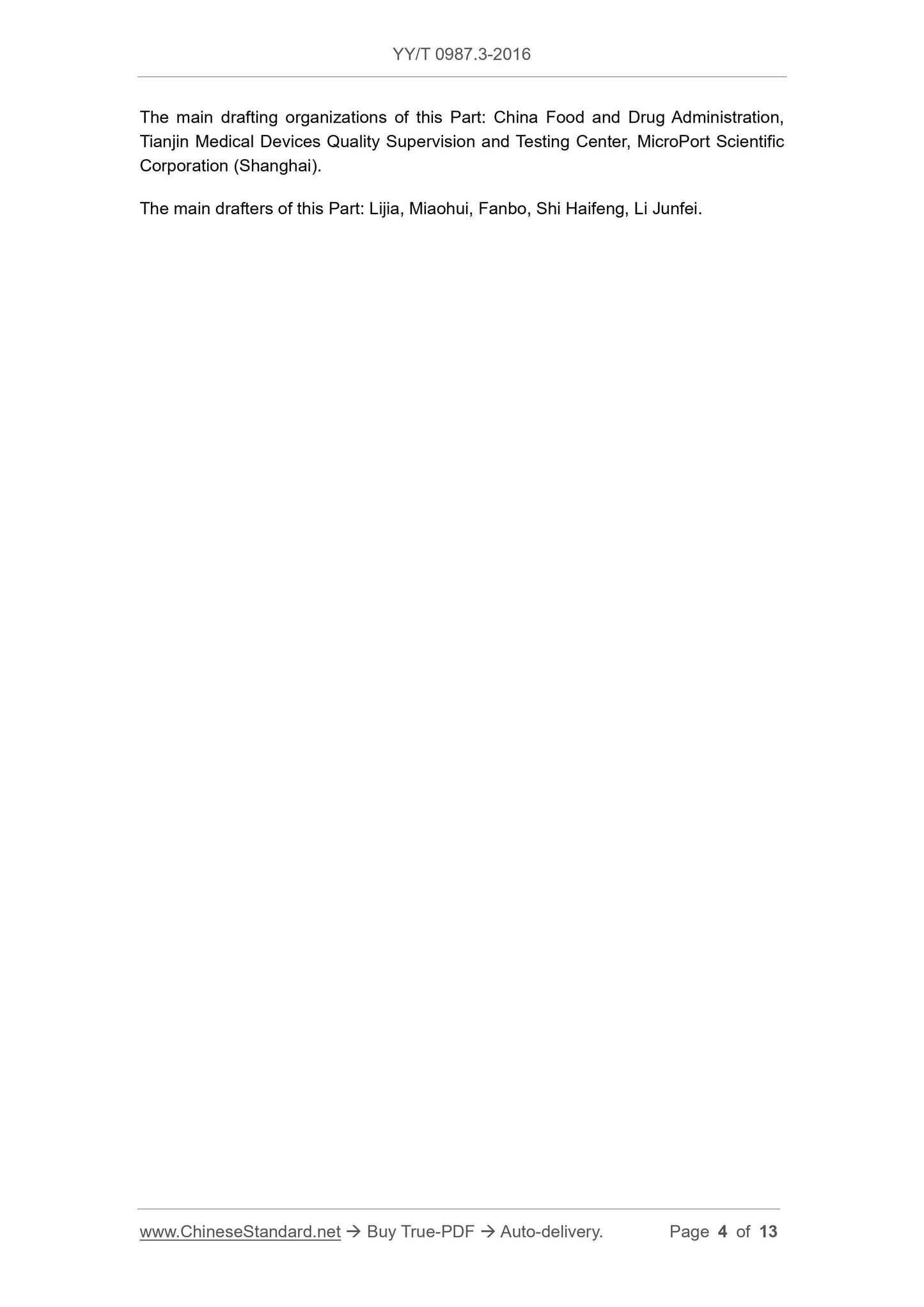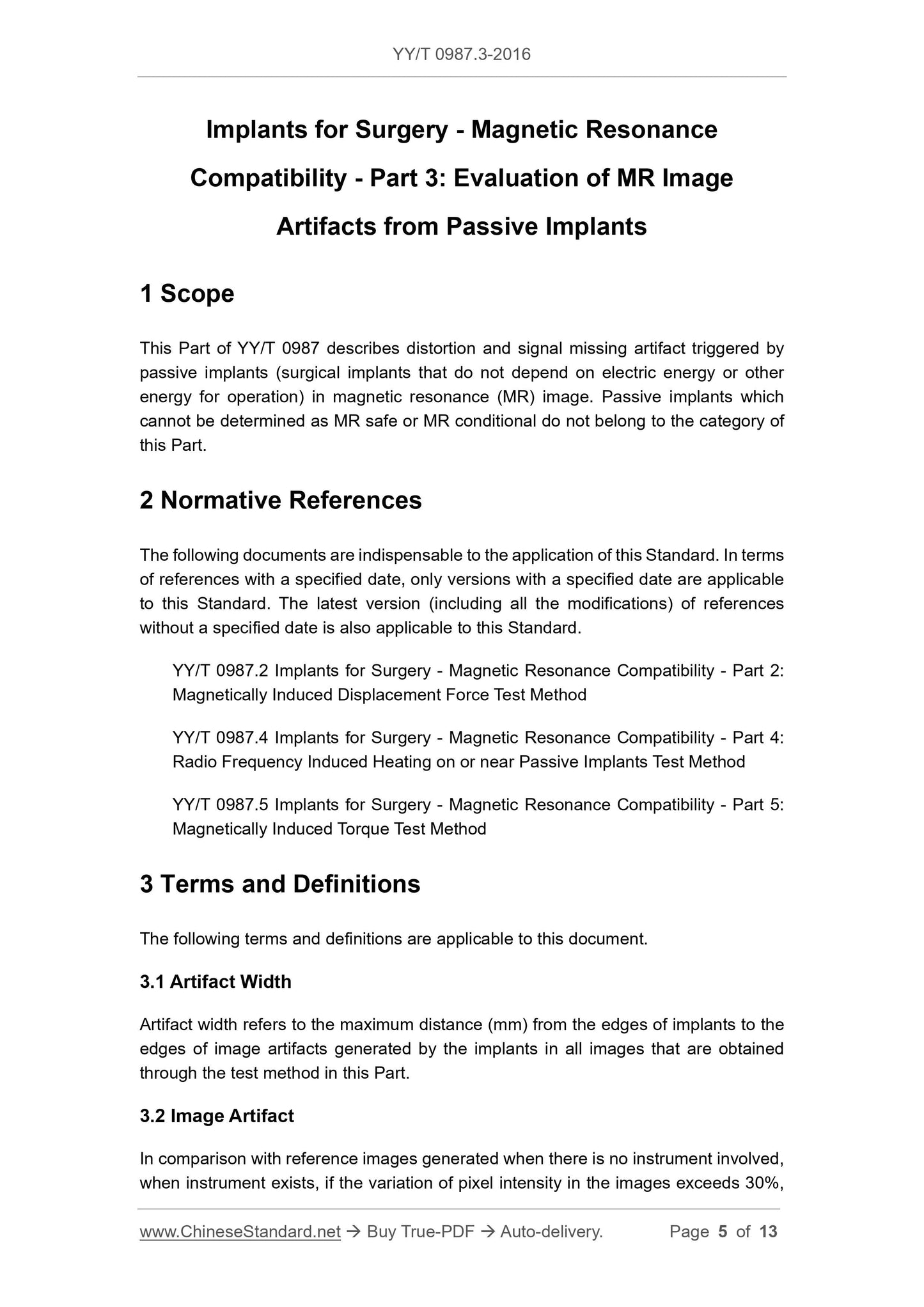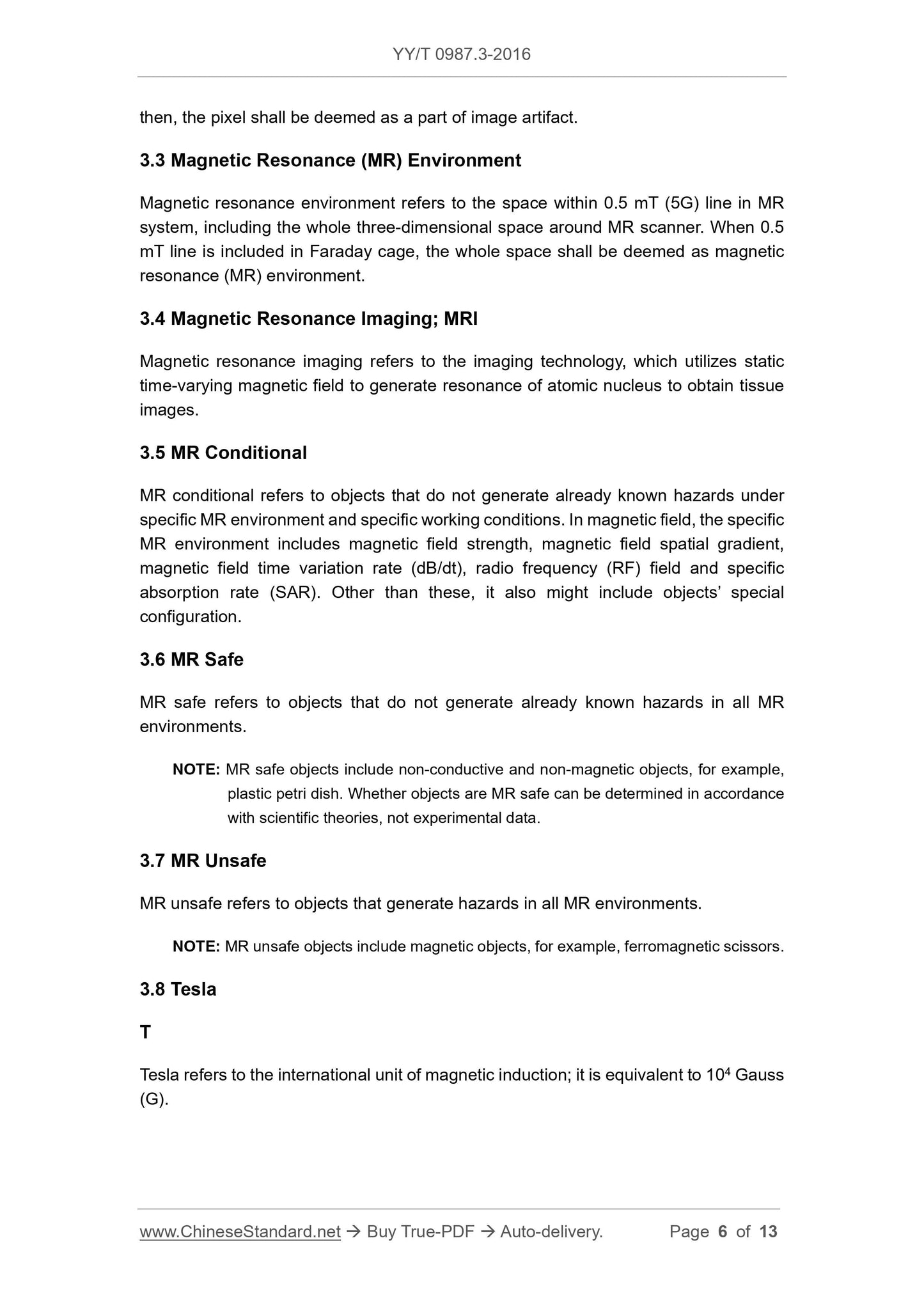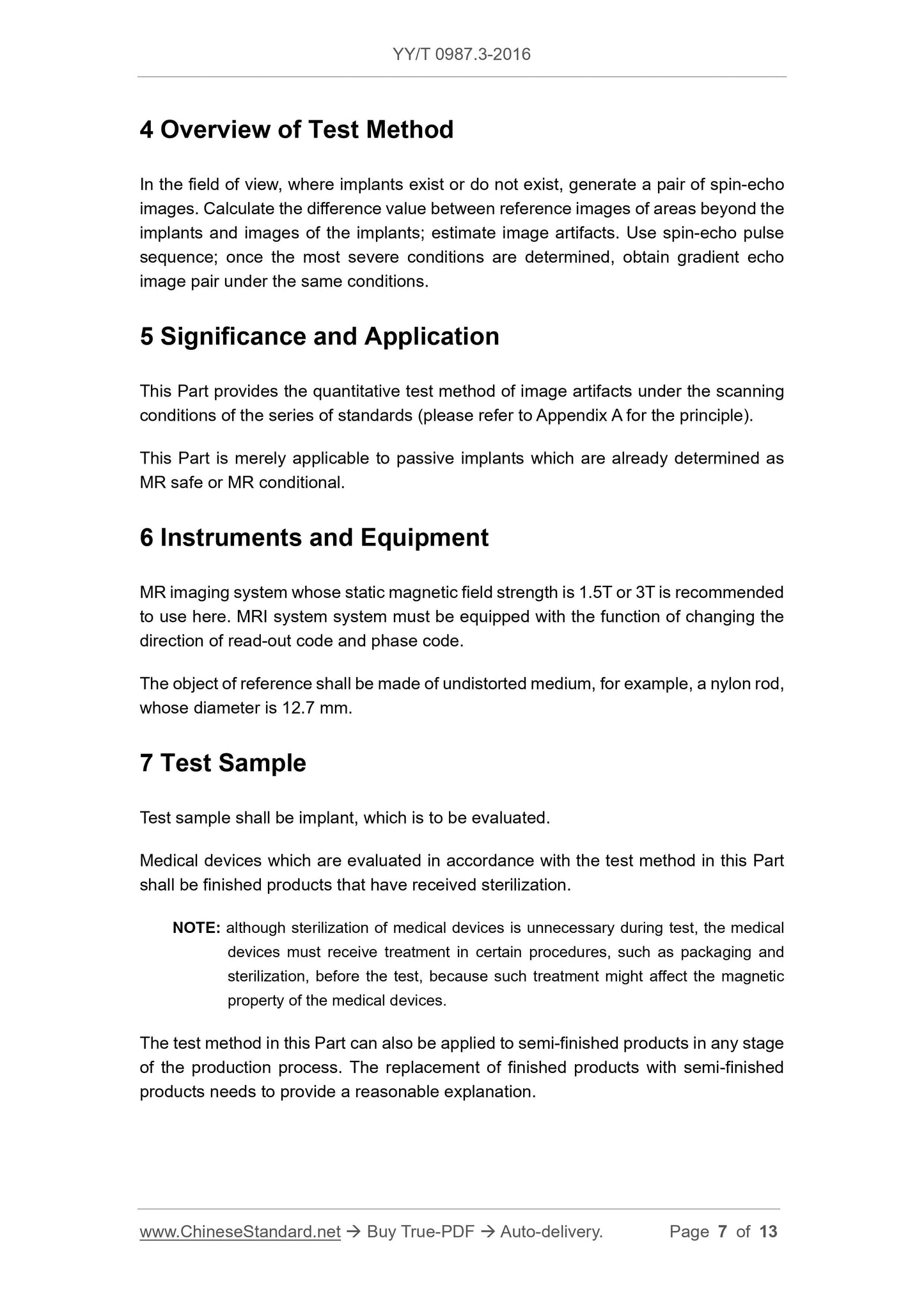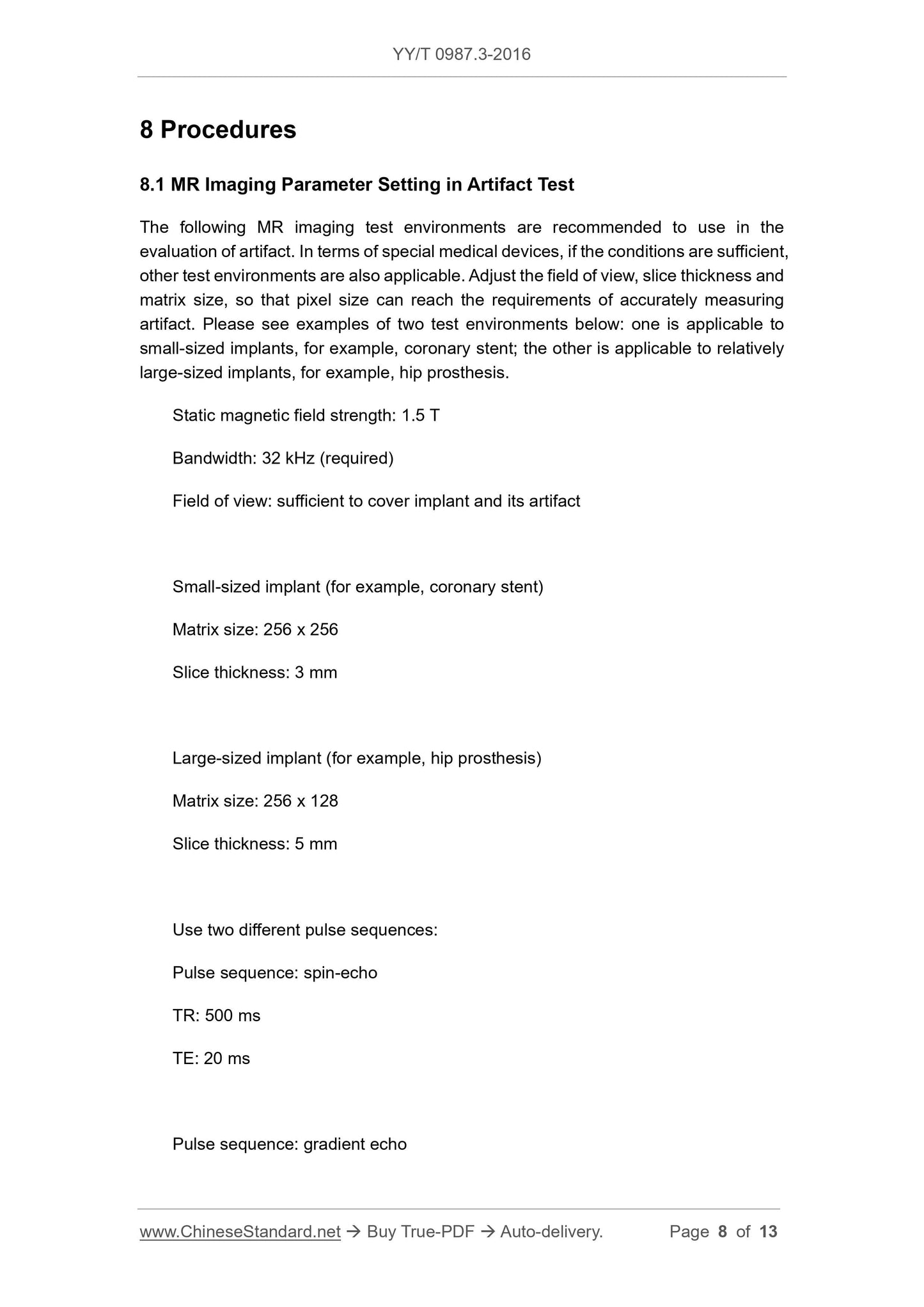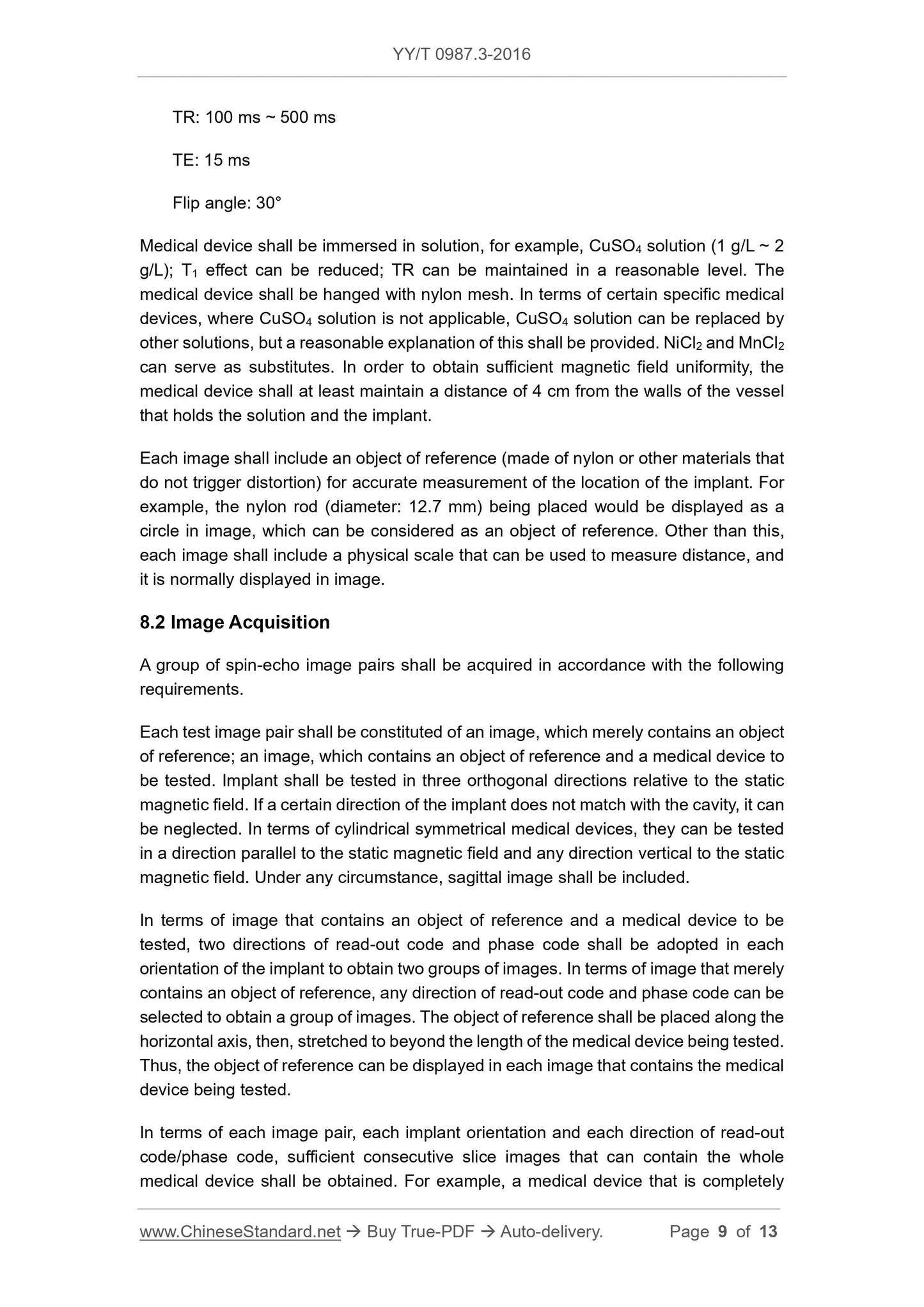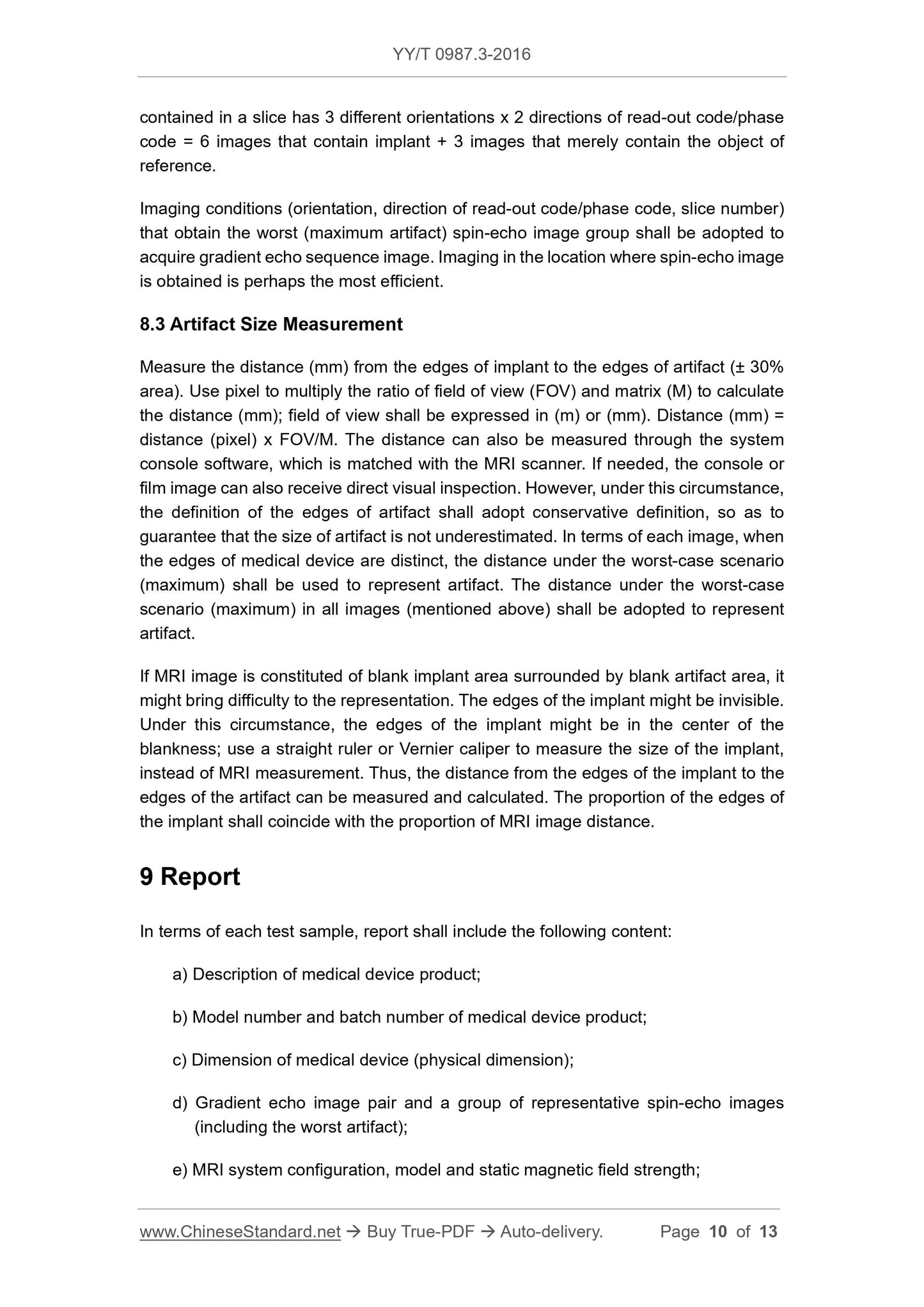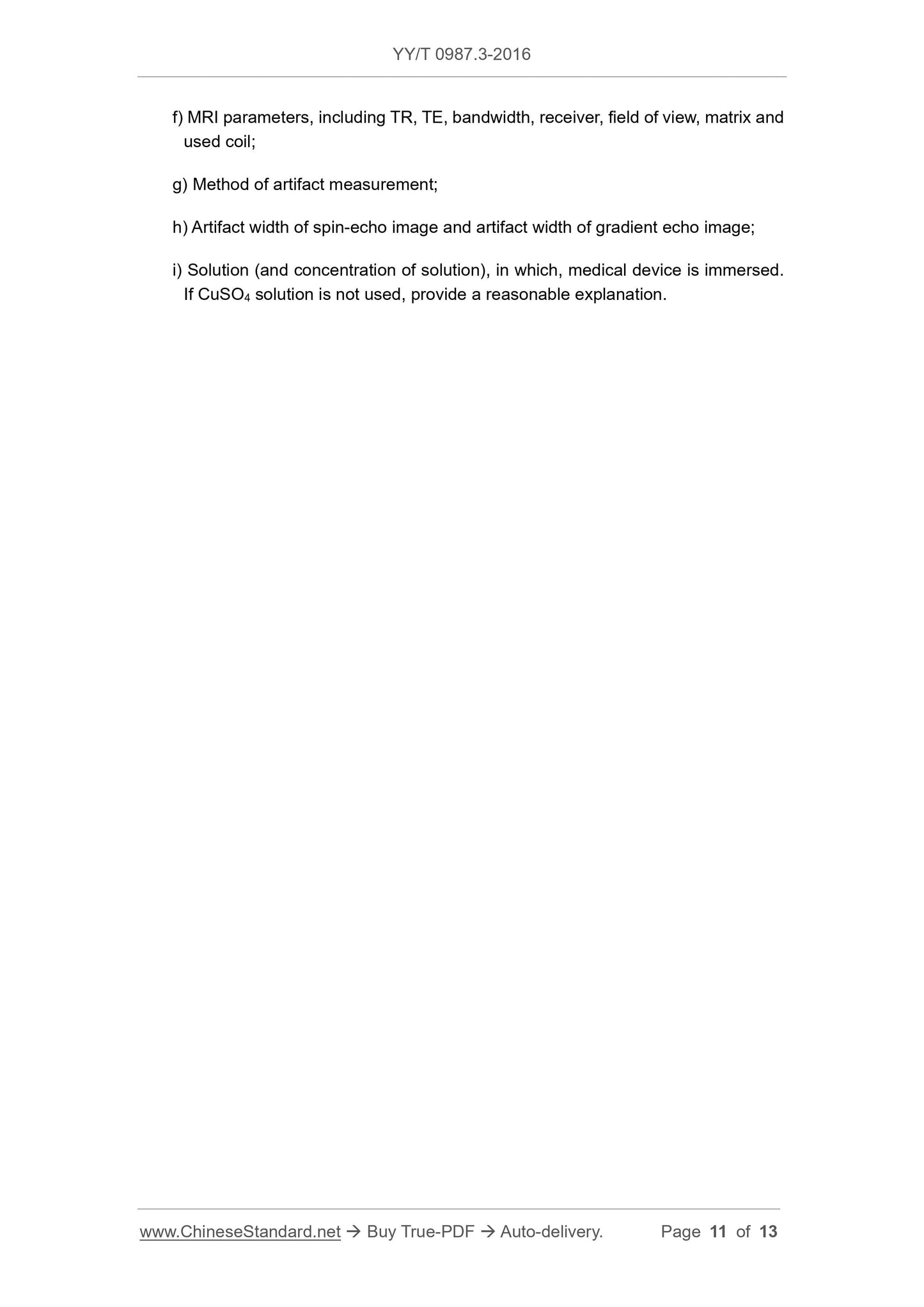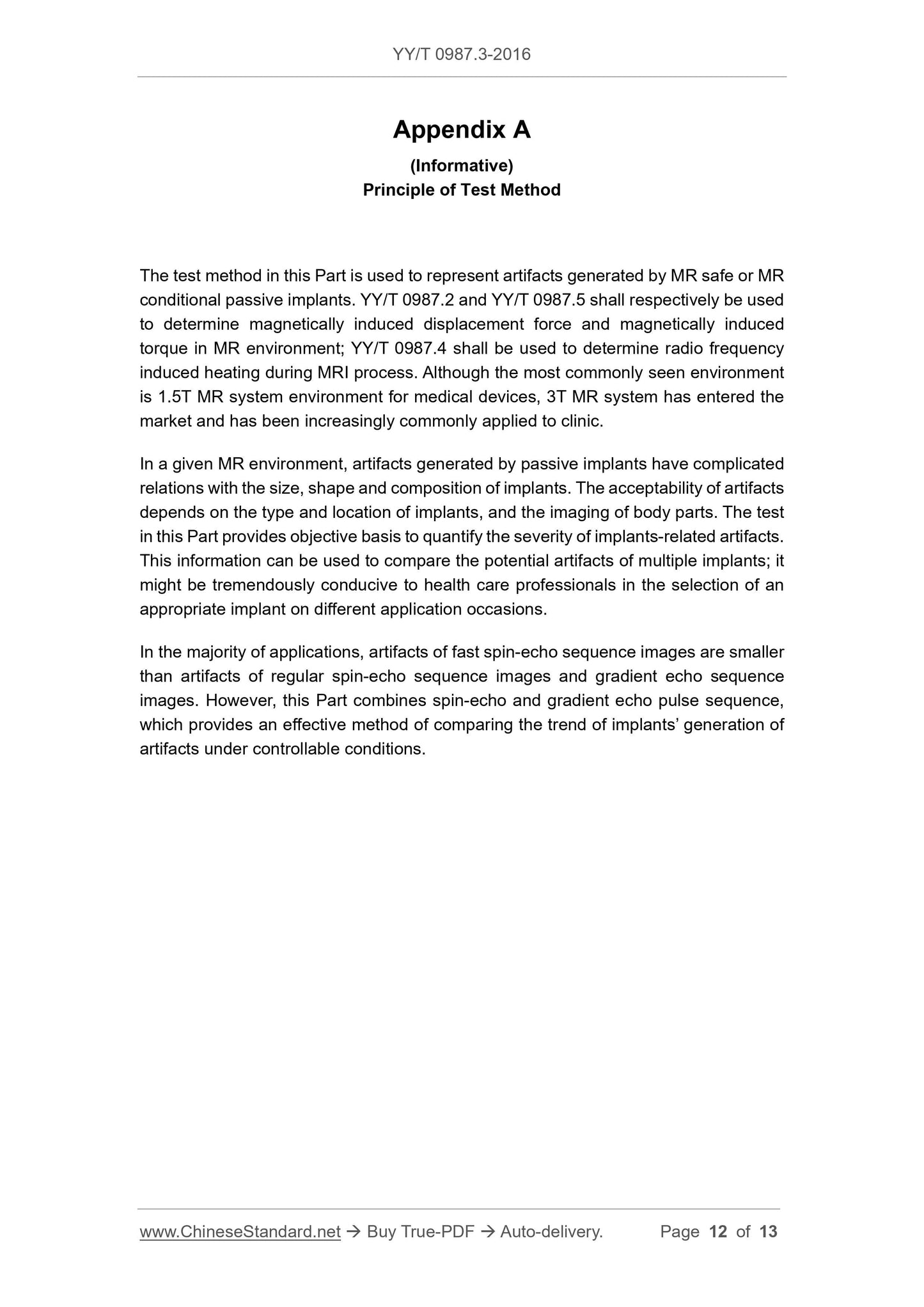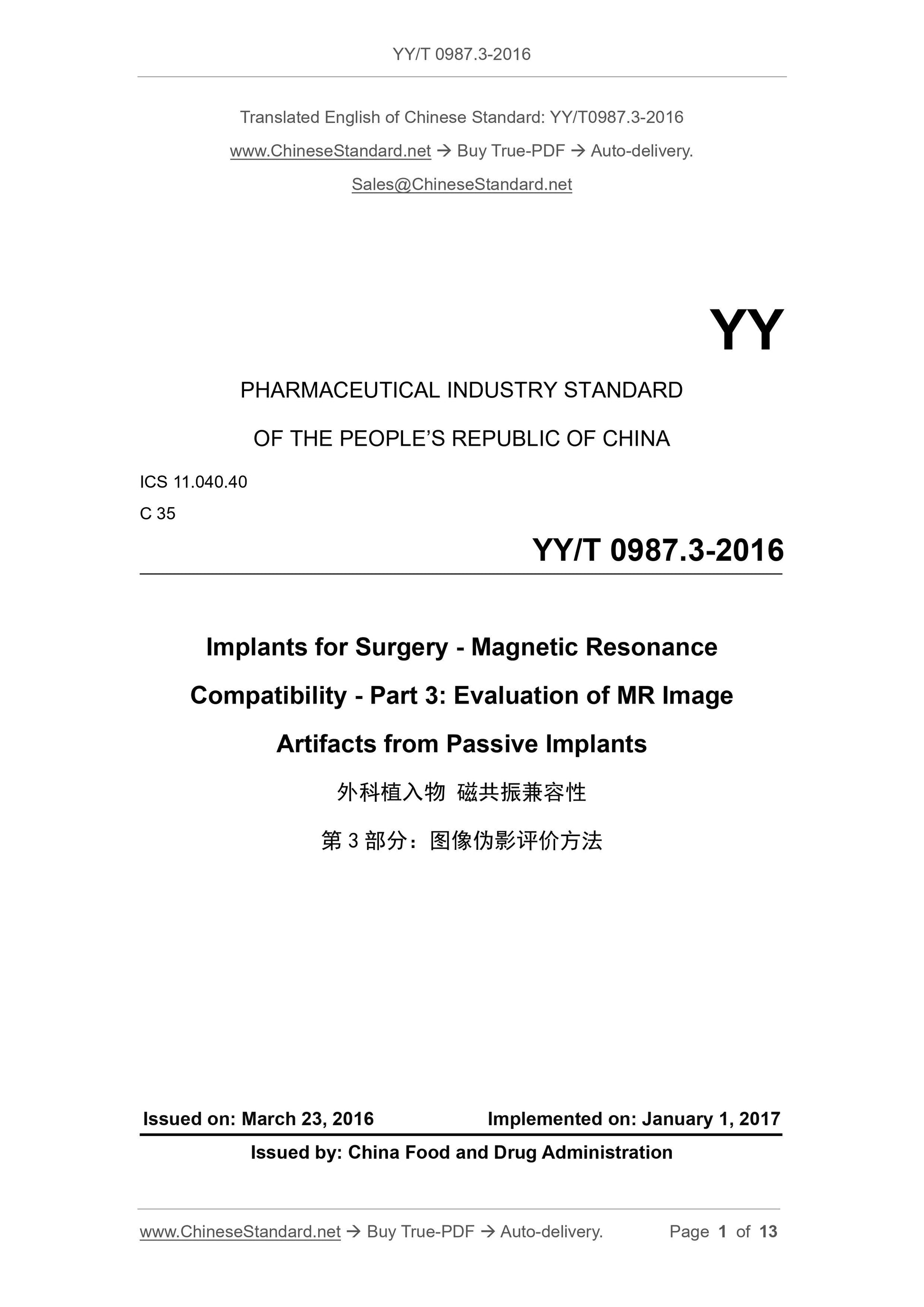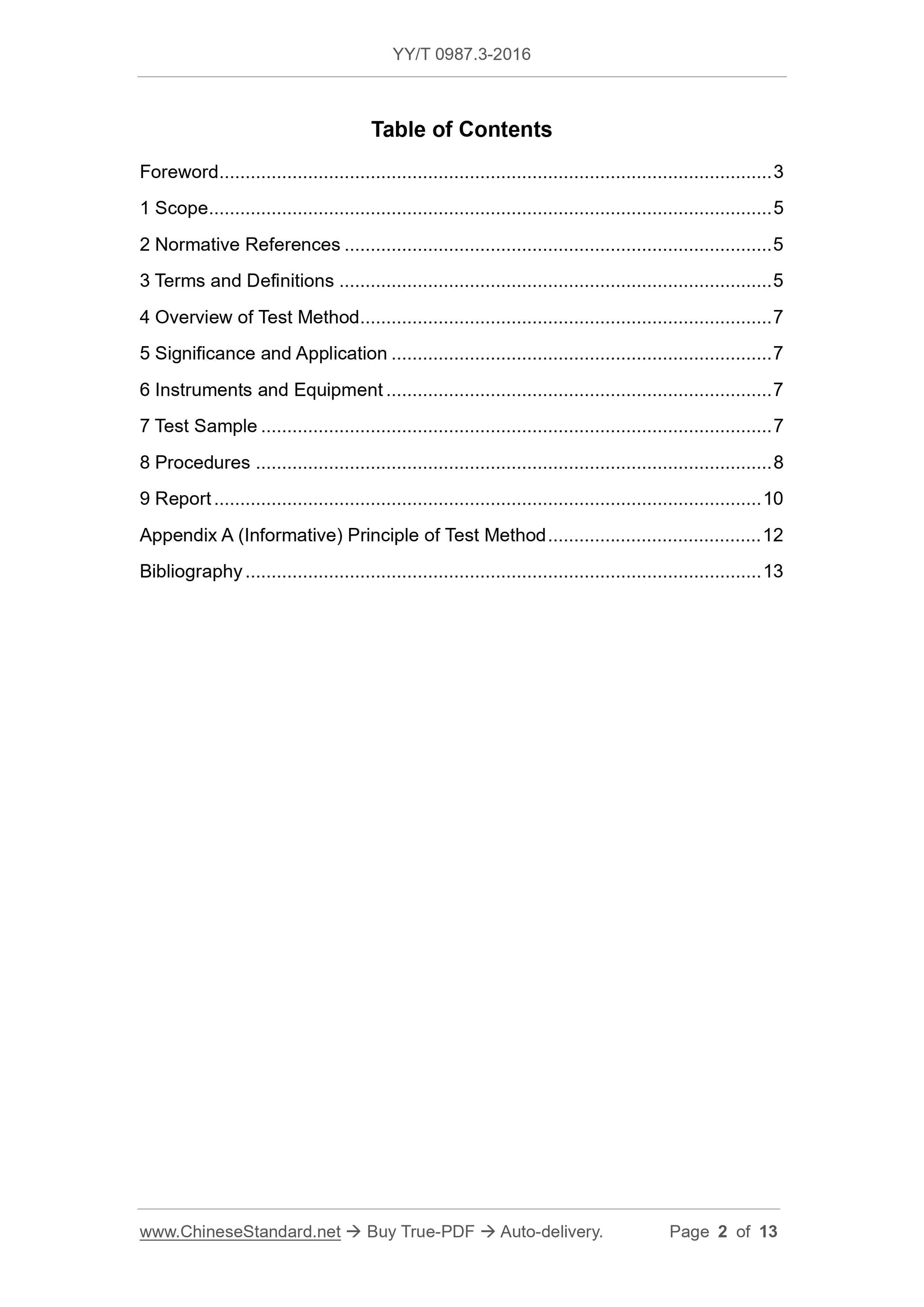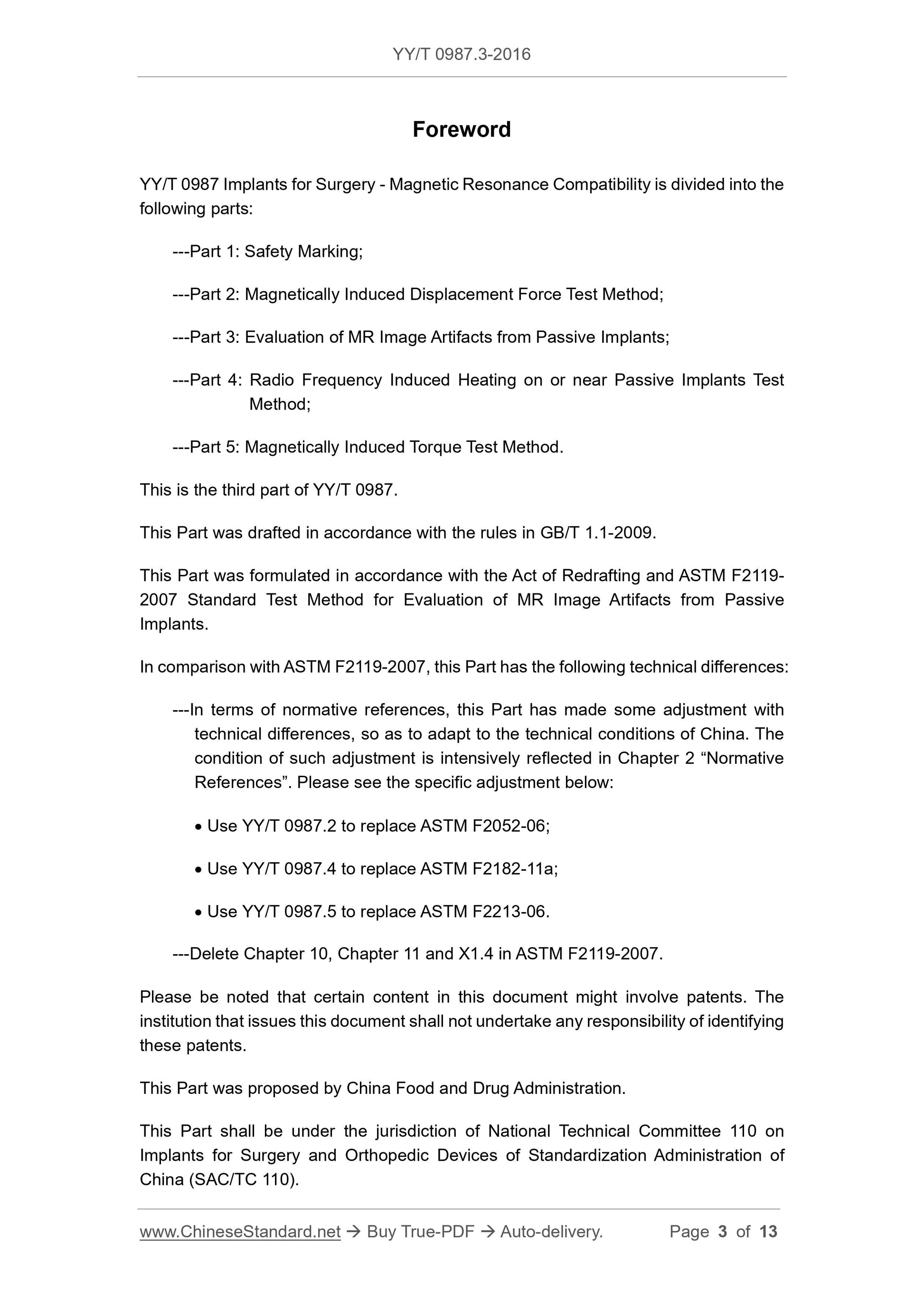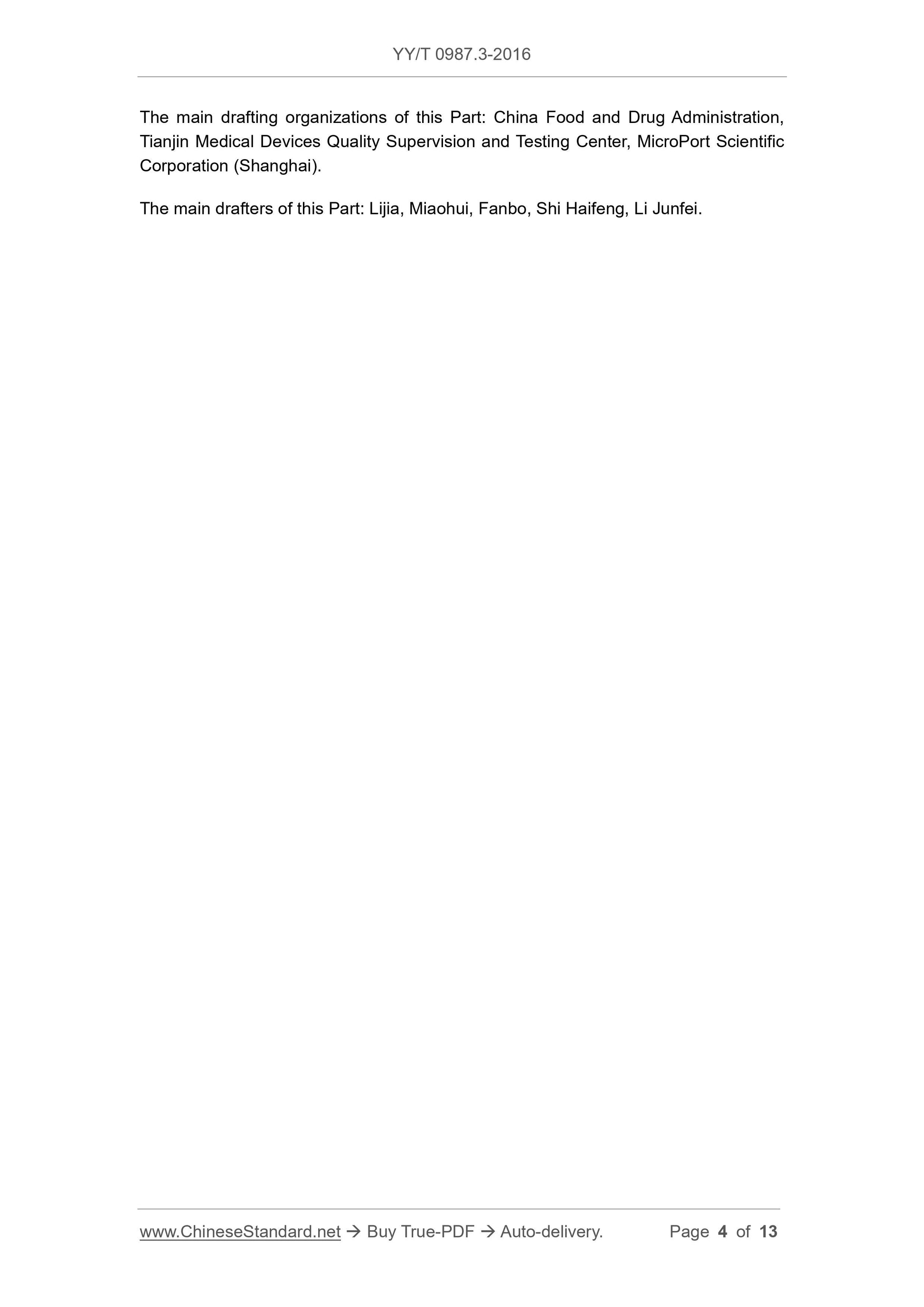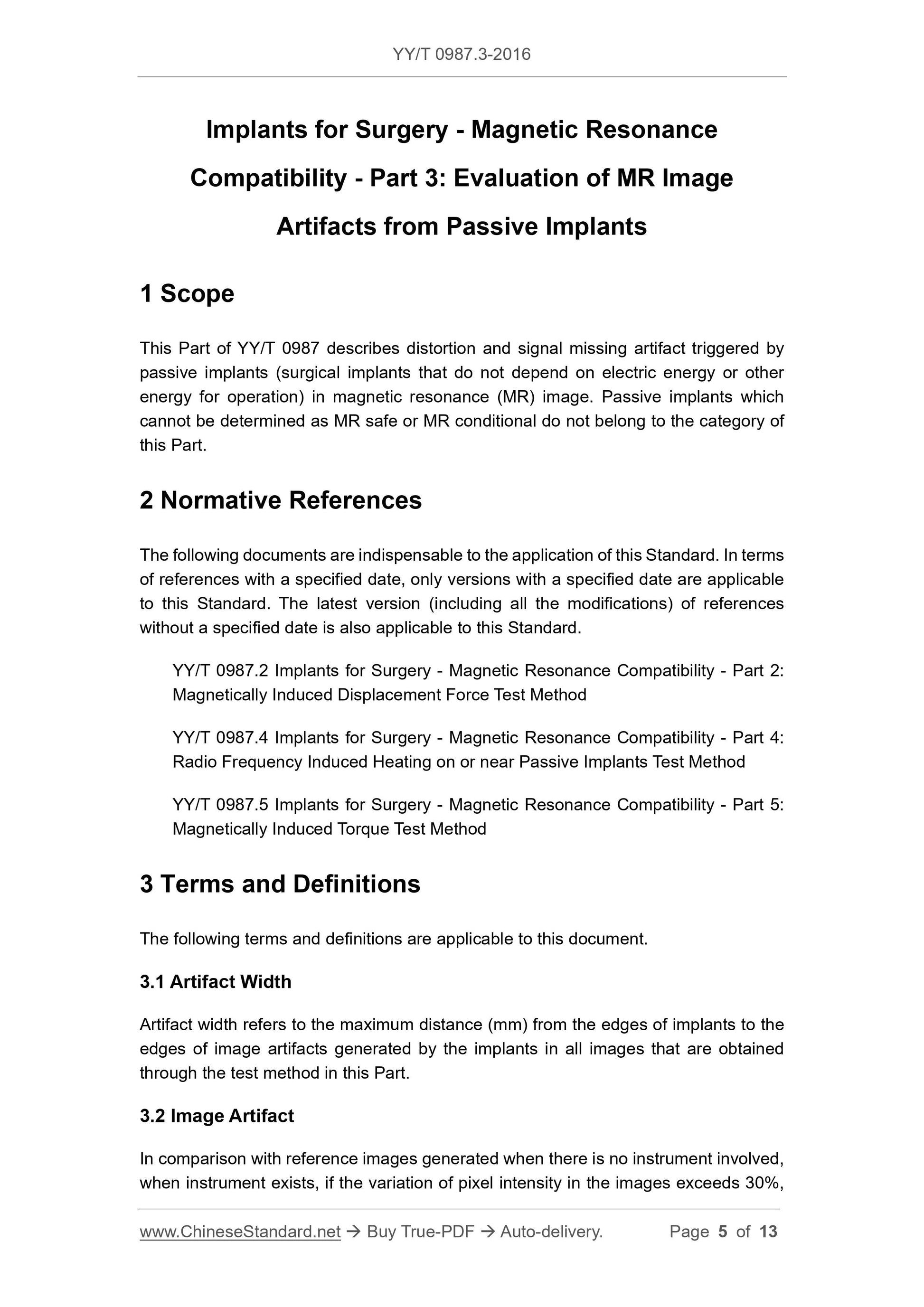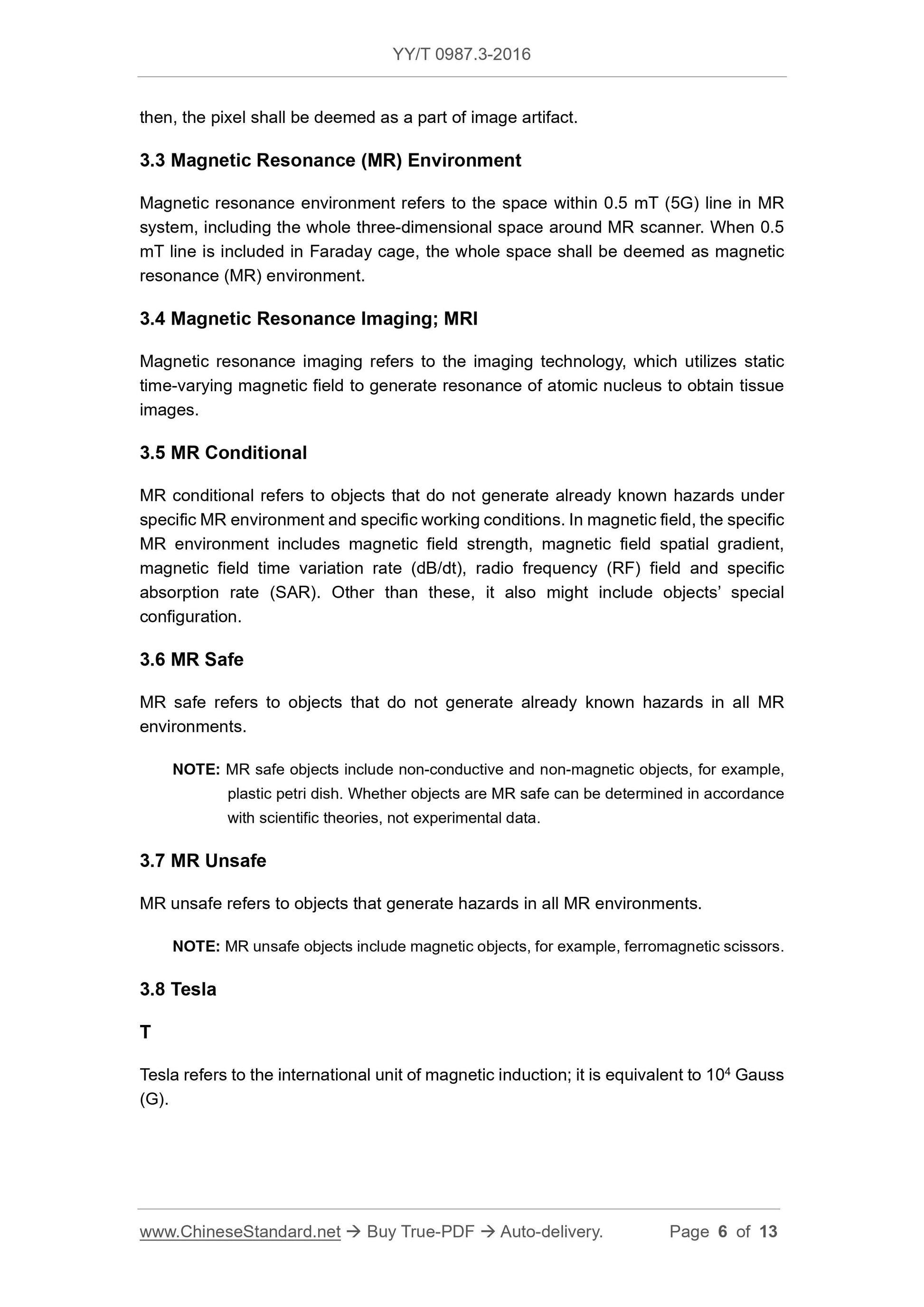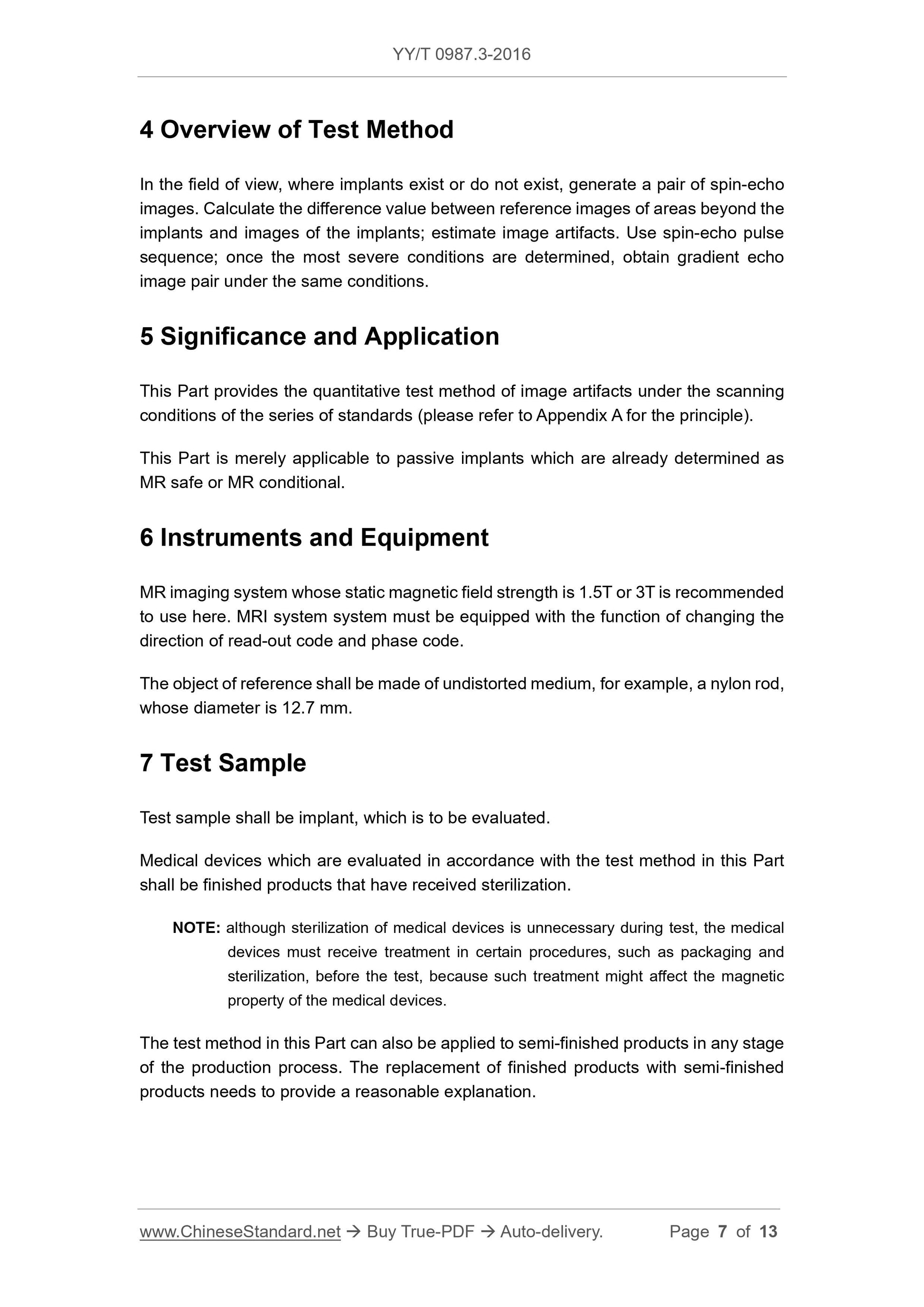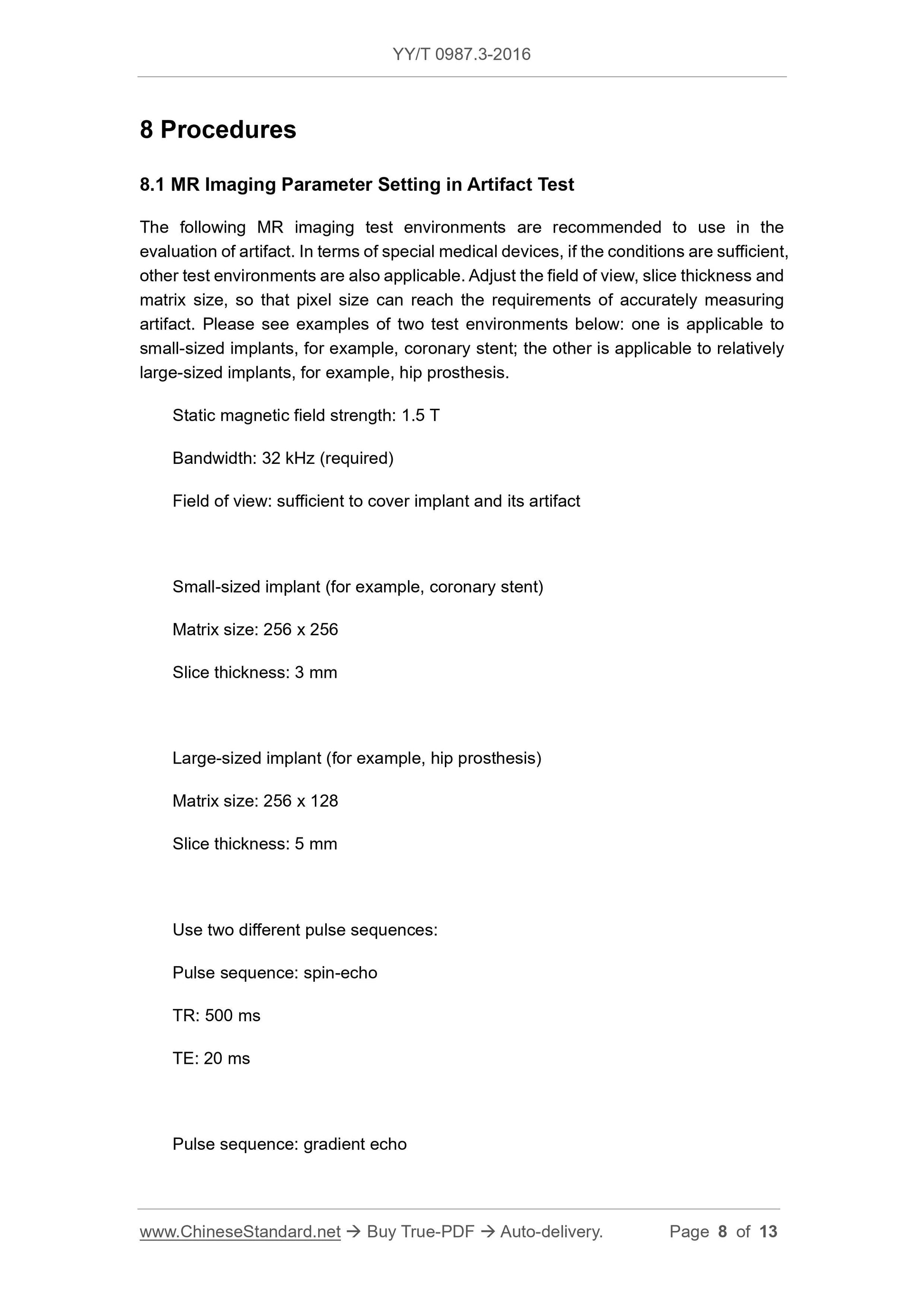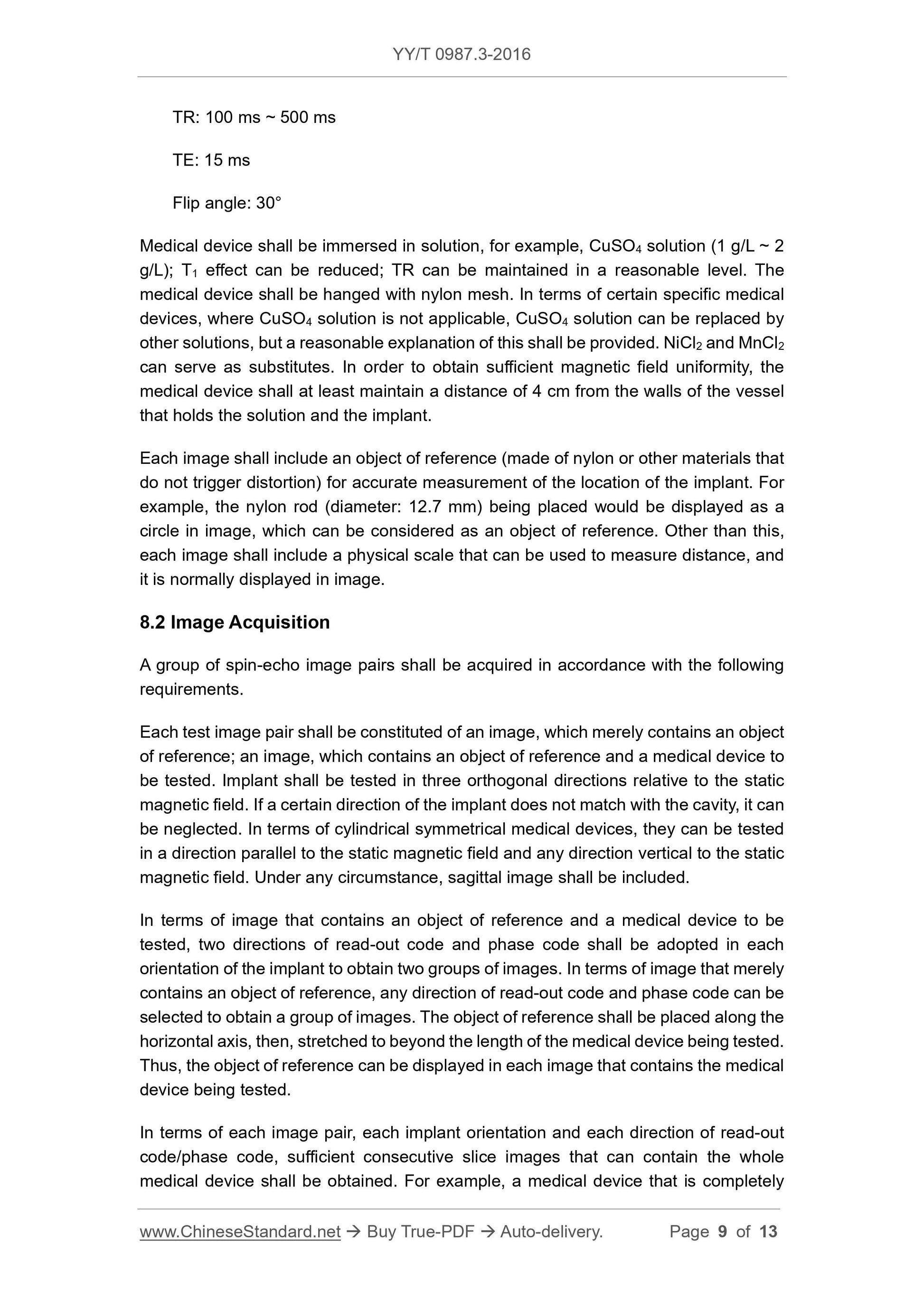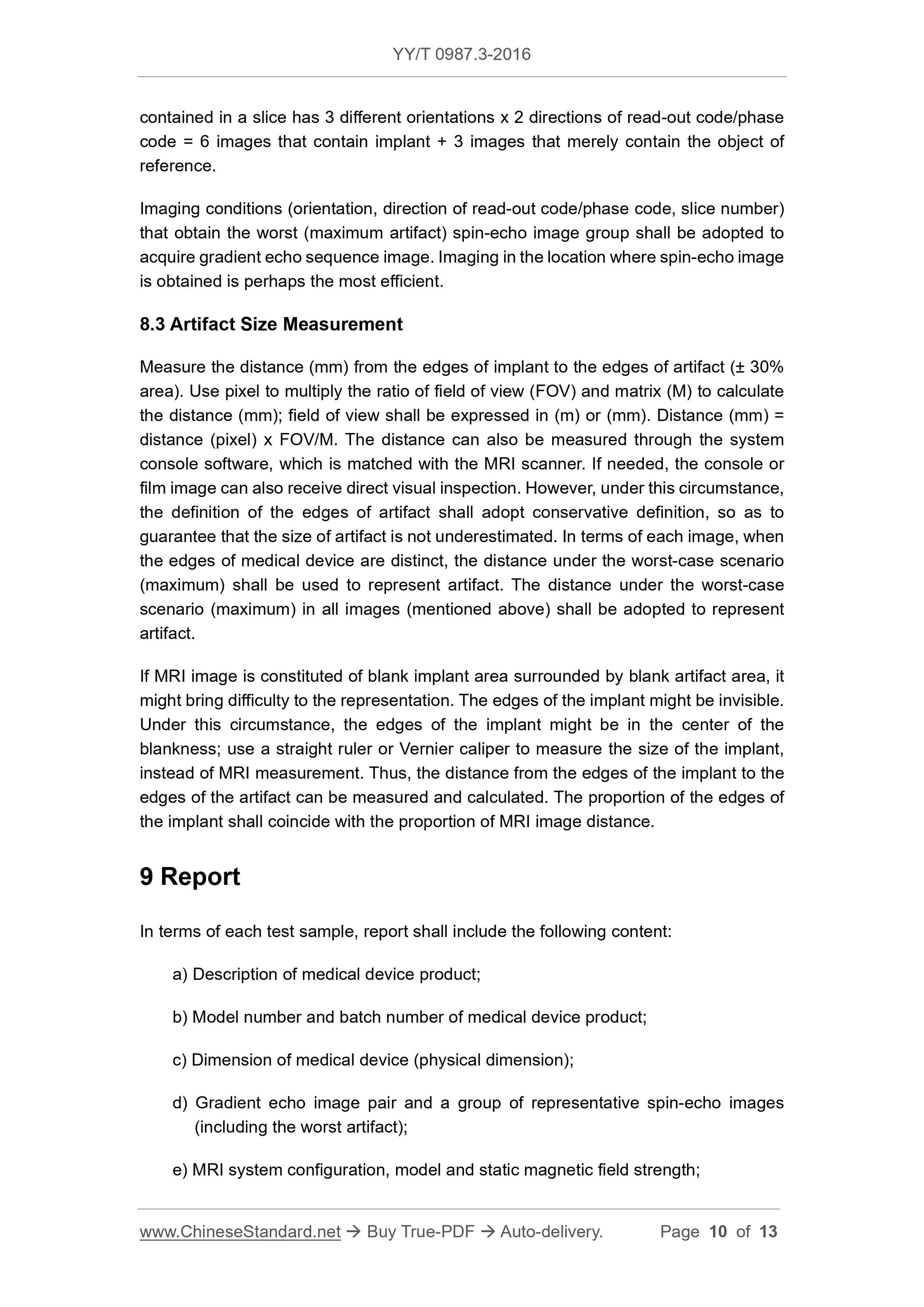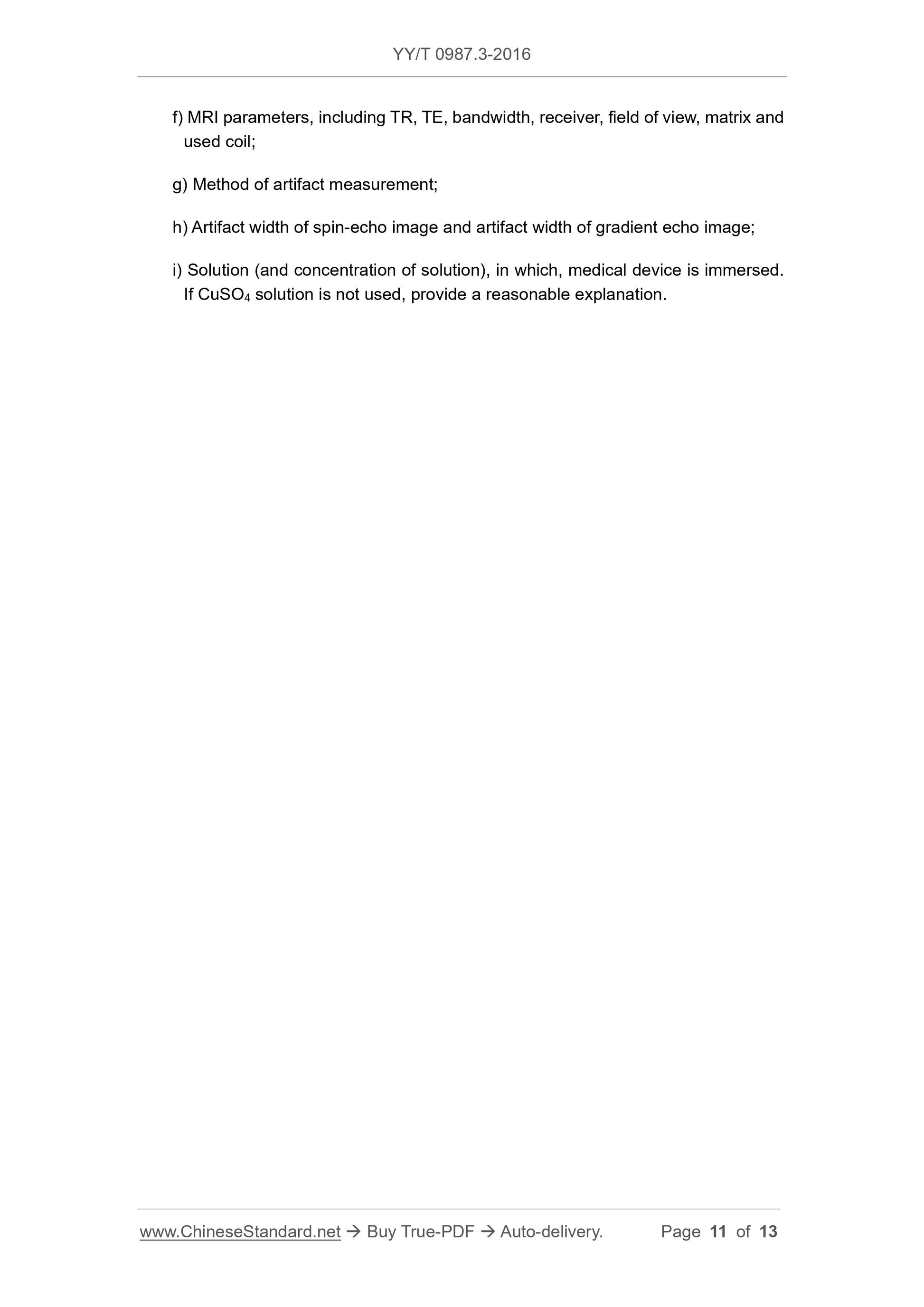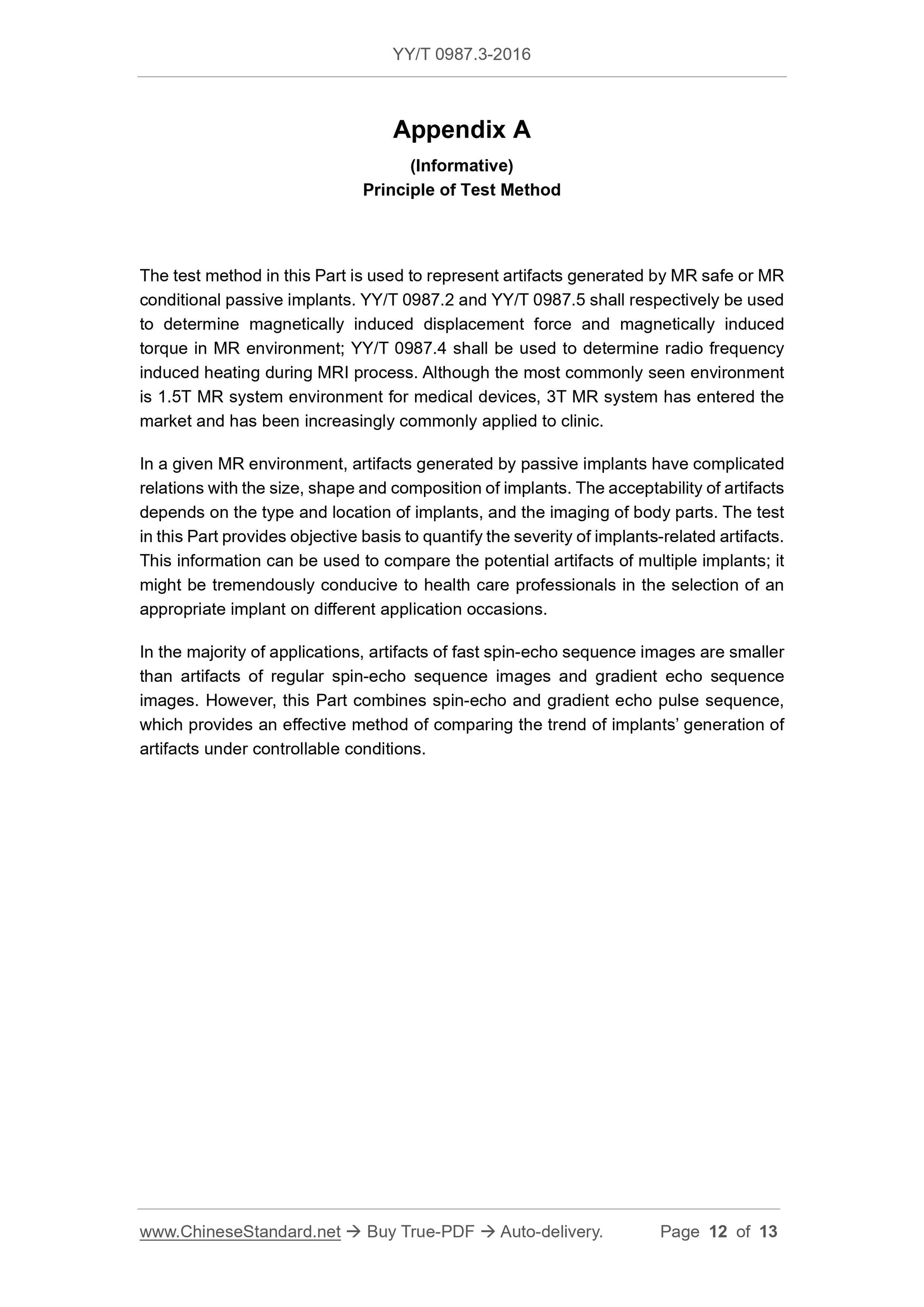1
/
su
12
PayPal, credit cards. Download editable-PDF & invoice in 1 second!
YY/T 0987.3-2016 English PDF (YYT0987.3-2016)
YY/T 0987.3-2016 English PDF (YYT0987.3-2016)
Prezzo di listino
$140.00 USD
Prezzo di listino
Prezzo scontato
$140.00 USD
Prezzo unitario
/
per
Spese di spedizione calcolate al check-out.
Impossibile caricare la disponibilità di ritiro
Delivery: 3 seconds. Download true-PDF + Invoice.
Get QUOTATION in 1-minute: Click YY/T 0987.3-2016
Historical versions: YY/T 0987.3-2016
Preview True-PDF (Reload/Scroll if blank)
YY/T 0987.3-2016: Implants for surgery--Magnetic resonance compatibility--Part 3: Evaluation of MR image artifacts from passive implants
YY/T 0987.3-2016
YY
PHARMACEUTICAL INDUSTRY STANDARD
OF THE PEOPLE’S REPUBLIC OF CHINA
ICS 11.040.40
C 35
Implants for Surgery - Magnetic Resonance
Compatibility - Part 3. Evaluation of MR Image
Artifacts from Passive Implants
外科植入物 磁共振兼容性
ISSUED ON. MARCH 23, 2016
IMPLEMENTED ON. JANUARY 1, 2017
Issued by. China Food and Drug Administration
Table of Contents
Foreword ... 3
1 Scope ... 5
2 Normative References ... 5
3 Terms and Definitions ... 5
4 Overview of Test Method ... 7
5 Significance and Application ... 7
6 Instruments and Equipment ... 7
7 Test Sample ... 7
8 Procedures ... 8
9 Report ... 10
Appendix A (Informative) Principle of Test Method ... 12
Bibliography ... 13
Implants for Surgery - Magnetic Resonance
Compatibility - Part 3. Evaluation of MR Image
Artifacts from Passive Implants
1 Scope
This Part of YY/T 0987 describes distortion and signal missing artifact triggered by
passive implants (surgical implants that do not depend on electric energy or other
energy for operation) in magnetic resonance (MR) image. Passive implants which
cannot be determined as MR safe or MR conditional do not belong to the category of
this Part.
2 Normative References
The following documents are indispensable to the application of this Standard. In terms
of references with a specified date, only versions with a specified date are applicable
to this Standard. The latest version (including all the modifications) of references
without a specified date is also applicable to this Standard.
YY/T 0987.2 Implants for Surgery - Magnetic Resonance Compatibility - Part 2.
Magnetically Induced Displacement Force Test Method
YY/T 0987.4 Implants for Surgery - Magnetic Resonance Compatibility - Part 4.
Radio Frequency Induced Heating on or near Passive Implants Test Method
YY/T 0987.5 Implants for Surgery - Magnetic Resonance Compatibility - Part 5.
Magnetically Induced Torque Test Method
3 Terms and Definitions
The following terms and definitions are applicable to this document.
3.1 Artifact Width
Artifact width refers to the maximum distance (mm) from the edges of implants to the
edges of image artifacts generated by the implants in all images that are obtained
through the test method in this Part.
3.2 Image Artifact
In comparison with reference images generated when there is no instrument involved,
when instrument exists, if the variation of pixel intensity in the images exceeds 30%,
4 Overview of Test Method
In the field of view, where implants exist or do not exist, generate a pair of spin-echo
images. Calculate the difference value between reference images of areas beyond the
implants and images of the implants; estimate image artifacts. Use spin-echo pulse
sequence; once the most severe conditions are determined, obtain gradient echo
image pair under the same conditions.
5 Significance and Application
This Part provides the quantitative test method of image artifacts under the scanning
conditions of the series of standards (please refer to Appendix A for the principle).
This Part is merely applicable to passive implants which are already determined as
MR safe or MR conditional.
6 Instruments and Equipment
MR imaging system whose static magnetic field strength is 1.5T or 3T is recommended
to use here. MRI system system must be equipped with the function of changing the
direction of read-out code and phase code.
The object of reference shall be made of undistorted medium, for example, a nylon rod,
whose diameter is 12.7 mm.
7 Test Sample
Test sample shall be implant, which is to be evaluated.
Medical devices which are evaluated in accordance with the test method in this Part
shall be finished products that have received sterilization.
NOTE. although sterilization of medical devices is unnecessary during test, the medical
devices must receive treatment in certain procedures, such as packaging and
sterilization, before the test, because such treatment might affect the magnetic
property of the medical devices.
The test method in this Part can also be applied to semi-finished products in any stage
of the production process. The replacement of finished products with semi-finished
products needs to provide a reasonable explanation.
TR. 100 ms ~ 500 ms
TE. 15 ms
Flip angle. 30°
Medical device shall be immersed in solution, for example, CuSO4 solution (1 g/L ~ 2
g/L); T1 effect can be reduced; TR can be maintained in a reasonable level. The
medical device shall be hanged with nylon mesh. In terms of certain specific medical
devices, where CuSO4 solution is not applicable, CuSO4 solution can be replaced by
other solutions, but a reasonable explanation of this shall be provided. NiCl2 and MnCl2
can serve as substitutes. In order to obtain sufficient magnetic field uniformity, the
medical device shall at least maintain a distance of 4 cm from the walls of the vessel
that holds the solution and the implant.
Each image shall include an object of reference (made of nylon or other materials that
do not trigger distortion) for accurate measurement of the location of the implant. For
example, the nylon rod (diameter. 12.7 mm) being placed would be displayed as a
circle in image, which can be considered as an object of reference. Other than this,
each image shall include a physical scale that can be used to measure distance, and
it is normally displayed in image.
8.2 Image Acquisition
A group of spin-echo image pairs shall be acquired in accordance with the following
requirements.
Each test image pair shall be constituted of an image, which merely contains an object
of reference; an image, which contains an object of reference and a medical device to
be tested. Implant shall be tested in three orthogonal directions relative to the static
magnetic field. If a certain direction of the implant does not match with the cavity, it can
be neglected. In terms of cylindrical symmetrical medical devices, they can be tested
in a direction parallel to the static magnetic field and any direction vertical to the static
magnetic field. Under any circumstance, sagittal image shall be included.
In terms of image that contains an object of reference and a medical device to be
tested, two directions of read-out code and phase code shall be adopted in each
orientation of the implant to obtain two groups of images. In terms of image that merely
contains an object of reference, any direction of read-out code and phase code can be
selected to obtain a group of images. The object of reference shall be placed along the
horizontal axis, then, stretched to beyond the length of the medical device being tested.
Thus, the object of reference can be displayed in each image that contains the medical
device being tested.
In terms of each image pair, each implant orientation and each direction of read-out
code/phase code, sufficient consecutive slice images that can contain the whole
medical device shall be obtained. For example, a medical device that is completely
contained in a slice has 3 different orientations x 2 directions of read-out code/phase
code = 6 images that contain implant + 3 images that merely contain the object of
reference.
Imaging conditions (orientation, direction of read-out code/phase code, slice number)
that obtain the worst (maximum artifact) spin-echo image group shall be adopted to
acquire gradient echo sequence image. Imaging in the location where spin-echo im...
Get QUOTATION in 1-minute: Click YY/T 0987.3-2016
Historical versions: YY/T 0987.3-2016
Preview True-PDF (Reload/Scroll if blank)
YY/T 0987.3-2016: Implants for surgery--Magnetic resonance compatibility--Part 3: Evaluation of MR image artifacts from passive implants
YY/T 0987.3-2016
YY
PHARMACEUTICAL INDUSTRY STANDARD
OF THE PEOPLE’S REPUBLIC OF CHINA
ICS 11.040.40
C 35
Implants for Surgery - Magnetic Resonance
Compatibility - Part 3. Evaluation of MR Image
Artifacts from Passive Implants
外科植入物 磁共振兼容性
ISSUED ON. MARCH 23, 2016
IMPLEMENTED ON. JANUARY 1, 2017
Issued by. China Food and Drug Administration
Table of Contents
Foreword ... 3
1 Scope ... 5
2 Normative References ... 5
3 Terms and Definitions ... 5
4 Overview of Test Method ... 7
5 Significance and Application ... 7
6 Instruments and Equipment ... 7
7 Test Sample ... 7
8 Procedures ... 8
9 Report ... 10
Appendix A (Informative) Principle of Test Method ... 12
Bibliography ... 13
Implants for Surgery - Magnetic Resonance
Compatibility - Part 3. Evaluation of MR Image
Artifacts from Passive Implants
1 Scope
This Part of YY/T 0987 describes distortion and signal missing artifact triggered by
passive implants (surgical implants that do not depend on electric energy or other
energy for operation) in magnetic resonance (MR) image. Passive implants which
cannot be determined as MR safe or MR conditional do not belong to the category of
this Part.
2 Normative References
The following documents are indispensable to the application of this Standard. In terms
of references with a specified date, only versions with a specified date are applicable
to this Standard. The latest version (including all the modifications) of references
without a specified date is also applicable to this Standard.
YY/T 0987.2 Implants for Surgery - Magnetic Resonance Compatibility - Part 2.
Magnetically Induced Displacement Force Test Method
YY/T 0987.4 Implants for Surgery - Magnetic Resonance Compatibility - Part 4.
Radio Frequency Induced Heating on or near Passive Implants Test Method
YY/T 0987.5 Implants for Surgery - Magnetic Resonance Compatibility - Part 5.
Magnetically Induced Torque Test Method
3 Terms and Definitions
The following terms and definitions are applicable to this document.
3.1 Artifact Width
Artifact width refers to the maximum distance (mm) from the edges of implants to the
edges of image artifacts generated by the implants in all images that are obtained
through the test method in this Part.
3.2 Image Artifact
In comparison with reference images generated when there is no instrument involved,
when instrument exists, if the variation of pixel intensity in the images exceeds 30%,
4 Overview of Test Method
In the field of view, where implants exist or do not exist, generate a pair of spin-echo
images. Calculate the difference value between reference images of areas beyond the
implants and images of the implants; estimate image artifacts. Use spin-echo pulse
sequence; once the most severe conditions are determined, obtain gradient echo
image pair under the same conditions.
5 Significance and Application
This Part provides the quantitative test method of image artifacts under the scanning
conditions of the series of standards (please refer to Appendix A for the principle).
This Part is merely applicable to passive implants which are already determined as
MR safe or MR conditional.
6 Instruments and Equipment
MR imaging system whose static magnetic field strength is 1.5T or 3T is recommended
to use here. MRI system system must be equipped with the function of changing the
direction of read-out code and phase code.
The object of reference shall be made of undistorted medium, for example, a nylon rod,
whose diameter is 12.7 mm.
7 Test Sample
Test sample shall be implant, which is to be evaluated.
Medical devices which are evaluated in accordance with the test method in this Part
shall be finished products that have received sterilization.
NOTE. although sterilization of medical devices is unnecessary during test, the medical
devices must receive treatment in certain procedures, such as packaging and
sterilization, before the test, because such treatment might affect the magnetic
property of the medical devices.
The test method in this Part can also be applied to semi-finished products in any stage
of the production process. The replacement of finished products with semi-finished
products needs to provide a reasonable explanation.
TR. 100 ms ~ 500 ms
TE. 15 ms
Flip angle. 30°
Medical device shall be immersed in solution, for example, CuSO4 solution (1 g/L ~ 2
g/L); T1 effect can be reduced; TR can be maintained in a reasonable level. The
medical device shall be hanged with nylon mesh. In terms of certain specific medical
devices, where CuSO4 solution is not applicable, CuSO4 solution can be replaced by
other solutions, but a reasonable explanation of this shall be provided. NiCl2 and MnCl2
can serve as substitutes. In order to obtain sufficient magnetic field uniformity, the
medical device shall at least maintain a distance of 4 cm from the walls of the vessel
that holds the solution and the implant.
Each image shall include an object of reference (made of nylon or other materials that
do not trigger distortion) for accurate measurement of the location of the implant. For
example, the nylon rod (diameter. 12.7 mm) being placed would be displayed as a
circle in image, which can be considered as an object of reference. Other than this,
each image shall include a physical scale that can be used to measure distance, and
it is normally displayed in image.
8.2 Image Acquisition
A group of spin-echo image pairs shall be acquired in accordance with the following
requirements.
Each test image pair shall be constituted of an image, which merely contains an object
of reference; an image, which contains an object of reference and a medical device to
be tested. Implant shall be tested in three orthogonal directions relative to the static
magnetic field. If a certain direction of the implant does not match with the cavity, it can
be neglected. In terms of cylindrical symmetrical medical devices, they can be tested
in a direction parallel to the static magnetic field and any direction vertical to the static
magnetic field. Under any circumstance, sagittal image shall be included.
In terms of image that contains an object of reference and a medical device to be
tested, two directions of read-out code and phase code shall be adopted in each
orientation of the implant to obtain two groups of images. In terms of image that merely
contains an object of reference, any direction of read-out code and phase code can be
selected to obtain a group of images. The object of reference shall be placed along the
horizontal axis, then, stretched to beyond the length of the medical device being tested.
Thus, the object of reference can be displayed in each image that contains the medical
device being tested.
In terms of each image pair, each implant orientation and each direction of read-out
code/phase code, sufficient consecutive slice images that can contain the whole
medical device shall be obtained. For example, a medical device that is completely
contained in a slice has 3 different orientations x 2 directions of read-out code/phase
code = 6 images that contain implant + 3 images that merely contain the object of
reference.
Imaging conditions (orientation, direction of read-out code/phase code, slice number)
that obtain the worst (maximum artifact) spin-echo image group shall be adopted to
acquire gradient echo sequence image. Imaging in the location where spin-echo im...
Share
